Jacqui Hellyer is manager of environmental communications for the Sydney Organising Committee for the Olympic Games (SOCOG).

Monday, 3 Apr 2000
SYDNEY, Australia
Well I’ve started the week on a high note, after having spent a wonderful weekend camping at Jervis Bay, a national park two hours south of Sydney. The absolutely pristine white sands, forest that comes down to the beach, kangaroos by day, possums by night, and trees full of galahs, rosellas, and other parrots are enough to lift the spirits of any jaded city dweller. Now that the season is cooling down it’s perfect camping weather, and my four-year-old son is at an age where he really enjoys it and we can even do some decent length bushwalks (we’re just about over that awkward stage where he’s too big to carry, but too little to walk far).
So on that high note, I started the day with one of my favourite tasks — briefing an international journalist on the “Green Games.” Makiko is a Japanese journalist from an environmental magazine, Eco21, doing a 10-page spread on the environmental aspects of the Sydney 2000 Olympic Games. It’s always a pleasure to brief these visiting journalists as they are so receptive and enthusiastic (although perhaps their good mood is due more to their having a lovely time visiting Sydney, which, it must be said, is a wonderful place to visit!). I wish the domestic media were as positive, but unfortunately the Australian media is not fond of good news stories and only seems to be interested in problems and scandals. It’s a shame, because there are some fabulous stories associated with these Games, particularly in the environmental area.
It was, in fact, due to these Games that I was lured back into working for the environment. Let me digress for a moment and indulge in a little self-reflection. For a number of years I thought I would never work in the environmental area again. After graduating from university with science and environmental management qualifications under my belt, I joined the federal Environment Department. After six years of endless effort working on heavy topics such as climate change and marine pollution — growing problems being insufficiently addressed — I decided I’d had enough. I was becoming pessimistic and negative. So I figured I needed a total change and went to live in Japan for four years, working on cross-cultural communication. It was only when I returned to Australia and was offered this job that I thought I’d give it a go.
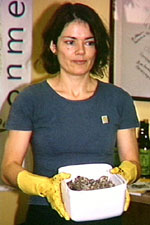
Just me and my worms.
The organizing committee had already made a strong commitment to the environment and I felt that the Games could provide an excellent means to push forward environmental issues. Two and a half years later, I’d have to say that I think we can feel pretty proud of what has been achieved. Even Greenpeace has given us a score of 7 out or 10 — which isn’t bad from an organisation better known for its criticism than its support! (I don’t want to brag and claim perfection here, far from it, but we are setting down a pretty good benchmark for future Olympic organising committees to improve upon.)
But back to my day. After talking to the journalist, I took her and a photographer down to see our commercial-scale worm farm (400,000 worms eat waste from the cafeteria kitchen), for yet more photos of me holding a handful of worms (it’s a great photo opportunity).
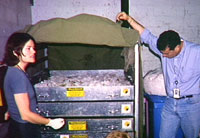
400,000 worms, training for the Sydney Olympics.
Then I was off to a meeting about our integrated waste branding system. It’s a bit of a mouthful, but basically it means that we are decorating all the food and drink packaging so that it’s colour-coordinated with the bins — and I must say it does look rather stylish (we have a good design team here — they’re closet greenies!). At Games-time there will be two types of bins in public places: one for recyclable material (cans, bottles, and plastic cups and containers) and one for compostable material (food scraps, cardboard plates, and biodegradable cutlery). All this material will be recycled and composted, and hopefully there will be very little which needs to be disposed of in landfill. It means developing new products, such as recyclable plastic wine glasses and biodegradable bin liners, to fit the system, and there will inevitably be some material which contaminates the system, but if it’s a low enough amount it won’t be a problem.
This afternoon was spent writing a section for a book on environmental technologies at the Games. I’d tell you more, but it looks like I’ve run out of space. And I haven’t even started to tell you about the traumas I’m having trying to get an environmental experience centre funded for Games-time. That will all have to wait until tomorrow. Till then, farewell.
Tuesday, 4 Apr 2000
SYDNEY, Australia
I was forced out of bed early this morning to have a picnic by the Harbour before work. One of the great things about living in Sydney is that there is so much water — the Harbour runs right through the centre of the city, with numerous bays and inlets. So we sat under a huge Morton Bay Fig and ate our croissants watching the boats and ships go by. Not quite as serene as camping at Jervis Bay, and without the range of bird life — and certainly no kangaroos grazing nearby — but not bad for the centre of a major city.
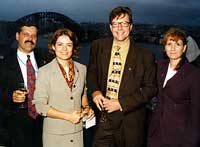
Sydney Harbour, with SOCOG’s Environment Program staff in the foreground.
So I started today on another high note and then got stuck into the environment centre I mentioned yesterday, which as of today I have renamed the Environment Pavilion. The idea behind the Pavilion is that while environmental initiatives pervade the Games, they are not obvious to the casual observer. So through interactive displays in an environmental experience centre, spectators and the media could see and understand these green initiatives. Great idea, but no funding. So I’ve been contacting all our sponsors, many of whom have been actively involved in developing the green games, as well as other organisations. As of today, it’s looking positive, so I’m keeping my fingers crossed. If it goes ahead there will be about ten exhibitions: the Australian environment, construction, alternative energy, ecology and remediation, greenhouse, catering and waste, transport, Greenpeace, Olympic Landcare, plus a video and a story board explaining why the environment is an Olympic issue. I’ll keep you informed on progress over the rest of the week.
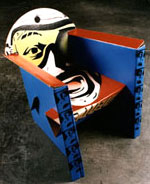
Recyclable cardboard furniture, around for a very limited time only.
Then I set to work planning how to spend a sum of money one of our sponsors has contributed for waste PR. We have four waste sponsors, each of whom covers one aspect of the waste loop: the provision of recyclable/biodegradable packaging; cleaning; waste transport; and sorting/disposal/composting/ recycling. One of these sponsors, Visy, does the first and part of the last of these steps — they provide the packaging and will recycle the clean paper, cardboard, and PET plastic. Visy’s whole business is devoted to recycling and producing products out of recycled materials (even providing furniture made from recycled ca
rdboard for the Games, and recycling it afterwards), so they have been a useful ally for us. And they have money, which is something we are sadly lacking. People always think SOCOG is loaded with money, and we do have a large budget, but it costs $A1.6 billion ($972 million American) to put on these Games, and every cent is allocated. So with this Visy money, we’ll be looking at promoting the integrated waste system, and more quirky (i.e., more readily picked up by media) issues like the composting, the biodegradable plastic cutlery, the cardboard furniture, and so forth.
After that I went to my lunchtime yoga class. We have them twice a week here in the building. It helps keep me sane.
Newly refreshed, I went into a two-hour meeting with the rest of the Environment Program staff to discuss all the issues we’re dealing with at the moment — recruitment and training of the environment volunteers who will be working with venue teams during the Games; operation of our environment information office in the Main Press Centre, where 15,000 accredited press will be located; the Environment Pavilion; organisation of the next, and final, Sponsors Environment Network meeting; the launch of the life-cycle analysis model developed by another of our sponsors, BHP, and how to convert it into a fun, user-friendly interactive computer tool. And some other issues.
By the way, the environment section of SOCOG’s website has been redone, so have a look. It will give you more background on some of the issues I’m talking about in this diary.
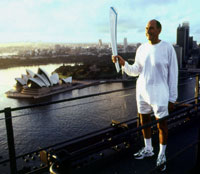
Australian Olympian Herb Elliot, taking the torch out for a test run.
And the last task for the day (other than writing this dairy entry) is to figure out what the greenhouse gas implications are of venting unspent fuel in the Olympic Torches. The Torch has been designed to the highest environmental specifications — in terms of the materials it is made from, its fuel efficiency (it uses approximately half the amount of fuel used in Atlanta for the same burn time and luminosity), and its packaging (another Visy recycled cardboard product — why does today’s entry read like one large plug for Visy??). Its one problem is that unburned fuel will be vented. We’d hoped to be able to capture it and burn it in the cauldron, but it proved too difficult for the relatively small amount of gas — about 40 grams for each torch. Now if I can just find my greenhouse gas conversion table (which seems to have been taken by those mysterious gremlins which inhabit offices stealing pens — and have you noticed that they have become technically literate and now take delight in deleting computer files?), I can finish my work and go home.
Back tomorrow.
Wednesday, 5 Apr 2000
SYDNEY, Australia
Another busy day. I managed to figure out that the 11,000 Olympic torches will release 2.8 tonnes of carbon dioxide, equivalent to a car travelling 9,000 kilometres. In Atlanta the 12,500 torches released 4.7 tonnes of carbon dioxide, the equivalent of a car travelling nearly 16,000 kilometres, so we’re a little greener on that front. How’s that for some Olympic trivia?
I’m still working on the Environment Pavilion, still trying to confirm financial contributions from the last few organisations and sponsors. Once we have that we’re set. It looks like one of the sponsors will second a person here to project-manage the whole thing, which would be great, as I couldn’t possibly fit that into my schedule as well.
It’s good that other organisations help us out financially and with staff. You’ve already heard about our financial woes, having a tiny budget and only four staff for the Environment Program. Fortunately, there are a lot of companies and organisations that want the “Green Games” to be a success and are willing to help out. Recently we had a new person start with us seconded from the state government to work on waste issues, relieving me of that workload (thank you, state government). I have a fairly regular stream of students working with me — at the moment one from Boston University. And Landcare Australia has its Olympic Landcare Project Manager working in our office regularly.

My son Ryan — and my arm — at a tree-planting event.
I haven’t mentioned Olympic Landcare yet — it’s another exciting project we’re involved in. Landcare Australia is a nationwide organisation of volunteer groups who do tree planting and other land remediation activities. Landcare came to us with a proposal for an Olympic project to take the “Green Games” concept out of Sydney and around the country by planting at least 2 million trees at 500 sites. We had tree-planting weekends at sites close to each capital city in September 1998 and 1999 and this year there will be a week of tree planting at all 500 sites in August. It’s a lot of fun to hop on the free train out to the site and work with all the other volunteers to plant trees. It’s so satisfying to watch the original empty site transform and at the end of the day be dotted with little trees and tree guards. And we can be confident there will be a high survival rate as part of the project is to ensure that the trees are well maintained after planting.
There is a lot of tree planting associated with these Games. In addition to Olympic Landcare, I’m also on the Greener Sydney 2000 Committee. This is a group with representatives from local government, state government authories, and Greening Australia, another tree planting organisation, with the aim of greening Sydney for the Games. Since it started in 1995, 3.7 million trees and shrubs have been planted, including about 350,000 by schools and volunteer groups. And of course there are hundreds of thousands of trees planted around Olympic venues, nearly all of them natives — which is better for the local biodiversity and conserves water as natives are more water tolerent (and I’d also argue that they look better). Sydney Olympic Park will be surrounded by the 440-hectare Millennium Parklands; the equestrian venue is in another major urban parkland; and the regatta centre, shooting centre, and velodrome have also all had major plantings associated with their developments.
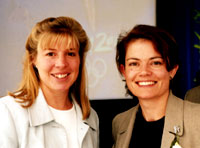
Me with Blair, a friend at Greenpeace.
But I digress, because I personally have had nothing to do with tree planting at venues, and I am supposed to be writing my diary, not doing a plug for the Green Games (although that is my job, so you’ll have to excuse me if I get a little carried away at times).
Today we also had the regular Olympic Environment Forum meeting. This is where we get together every two weeks with Greenpeace, Green Games Watch 2000 (a coalition of green groups), the Environment Protection Authority, and the Olympic Coordination Authority (the government agency overseeing the construction of new venues) to discuss various issues. Greenpeace has been involved since the beginning and we have good relations with them. The Forum is a way of keeping communciation open, so it’s run in an informal manner.
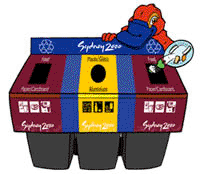
Syd the platypus.
Then I had an expected meeting with the Federal Environment Department (another well-funded organisation that is keen to work with us to promote the environment) about becoming involved in National Threatened Species Day. It’s a slightly tenuous link, but the Olympic mascots are all unique Australian creatures — Sy
d the platypus, Millie the echidna, and Olly the kookaburra — so it would be good to have them promote the plight of so many of our native species. Now it’s a matter of going through all the approval processes to enable this to happen, a job for my able assistant.
And that was my day at work.
Thursday, 6 Apr 2000
SYDNEY, Australia
Good news! It looks like the Environment Pavilion is a happening thing! We now have enough financial commitment to proceed, barring some unforeseen disaster. I am so pleased. It has been a hard slog to get to this point, and there’s more hard work ahead, but it will be a wonderful addition to the Games, and an excellent forum for getting across the “Green Games” messages.

Our Olympic environment logo.
The other events of the day pale in comparison to that news. One good thing is that we again have permission to use the Olympic environment logo. We developed a special Olympic environment “look” and logo to give the program a profile. Usually only sponsors who have paid large sums of money can use an Olympic logo, but our idea was to use the environment logo to give some Olympic affiliation to green groups and other organisations with specifically environmental projects. Our plan was almost spoiled by a new system of “coordinated communications” across all the Olympic agencies that calls for the use of only one standard Olympic logo. But today I managed to convince the powers that be that there are certain situations, such as us supporting National Threatened Species Day, that require the environment logo because use of the official Olympic logo is inappropriate (and, in fact, illegal). Hooray, another win for the day.
On a lighter note, I had some fun organising the next get-together of EcoChicks. This is a network of young(ish) women working in the environment field, many working within industry. It started because a few of us working on Olympic-related environment issues (the environment managers of the construction consortium building the Olympic Village hotel and an employee of one of our Olympic sponsors) became friends and regularly met to discuss work, as well as girlie things like where to get a good haircut. We realised that there were plenty of other women in similar positions, so we set up the network. Now we meet once a month, sometimes just for dinner, sometimes for other activities. Last month we went on a “ghost tour” of the old quarantine station here in Sydney where passengers on infected ships had to spend two weeks before being allowed into the country. This month we are doing a cappella singing with a group that specialises in environmental songs. It’s a particularly good support network for those of us who work within industry, as the corporate culture can be oppressive and not particularly conducive to environmental progress.
I met a lovely lady from the Washington Post today. She was feeling a little disoriented from the jet lag and the fact that the sun is in the north and not the south, but enjoying her stay nonetheless. She was looking forward to seeing a real echidna (one of our mascots, Millie, is an echidna), which is an indigenous spiny anteater. She had already seen a platypus and a kookaburra, our other two mascots, but not a frill-necked lizard, the Paralympic mascot. The Post is starting a kids section and is looking for good Olympic environmental stories. I think I managed to impress her with the range of issues related to the “Green Games” and their appeal to kids. I’ll look forward to working with the writers on those stories.
However, that unexpected briefing has put me behind in my schedule today, so I’ll have to finish this diary entry early and get back to work on the Environment Pavilion. I have to sort out all those dull issues to do with contracts and financial arrangements. I can see that I’m going to be here a while longer. But once it’s done I’m off to see a movie about dolphins at the IMAX cinema this evening — should be good.
Until tomorrow …
Friday, 7 Apr 2000
SYDNEY, Australia
So ends another week. Twenty-three more to go until the start of the Olympic Games. So little time, so much to do. Can we even get the Environment Pavilion built in such a short space of time? And today’s drama was that we are supposed to go to tender, yet there is absolutely no way we have time to go through that process. Let’s hope we can sort that one out.
You readers won’t get to hear the end of this ongoing saga, but for those of you planning to come to Sydney to see the Games, look out for the Pavilion (I’m convinced it will go ahead, even with the constant obstacles to be overcome), ask for me, and we can have a drink together. I’ll probably need the drink — the Games are going to be fairly hectic. But then I’ll take a nice long holiday. And then I’ll have to find another job. This is just a none-too-subtle plug for myself: If any of you dear readers will be needing someone with the rare combination of a science background and excellent communication skills, I’m available from the first of November!
I had rather a long lunch today (well, it is Friday). SOCOG’s Environment Program had lunch with the Olympic Co-ordination Authority’s (OCA) Environment Branch. I’ve explained before that the OCA is responsible for “building the stage,” so to speak, because they oversee the construction of new venues and the remediation of Homebush Bay, where the main Olympic site is located. SOCOG “puts on the show,” i.e., runs the events. So it’s good to socialise occasionally, rather than just seeing each other at meetings.
Lunch was in the newly opened Ibis and Novotel Homebush Bay Hotel out at Sydney Olympic Park. It’s a marvellous example of the environmentally sound buildings associated with the Games. It has the largest solar hot waste system in the Southern Hemisphere on its roof, it purchases 100 percent of its electricity from renewable sources, it has an environment manager (my good friend Gabrielle, one of the founding EcoChicks, which I mentioned yesterday), it gives $1 per room night to WWF, its windows open, and it doesn’t have lots of little shampoo bottles in the rooms — plus many other features. You can also get a great view of the whole site from the observation level at the top of the hotel, and there is an excellent display about the environmental features of the hotel and its involvement with WWF.
After the pleasant trip out there and back, it was time to get a dreaded flu vaccination. With winter approaching, and a lot more work to be done, we don’t want half the staff to come down with the flu, so it was free vaccinations for all today. Also blood pressure, cholesterol, and other health advice was available. We are constantly being exhorted to look after ourselves and not burn out before the Games begin.
Tonight I have the rather daunting task of entertaining the manager of one of Australia’s most exclusive catering companies — and I’m cooking! Aargh! Just a wee bit intimidating. He’s a new friend of my husband’s and he heard that I do Japanese home-style cooking (having lived there for four years), so the dinner was arranged. I think I’ll be drinking a bit of sake to get my courage up. I just hope he’s as pleasant a chap as my husband claims — because I can’t claim to be a great cook.
So I bid you all a fond farewell as I head home to whip up a storm in the kitchen. Wish me luck with the Environment Pavilion, and do look me up if you are here during the Games.

